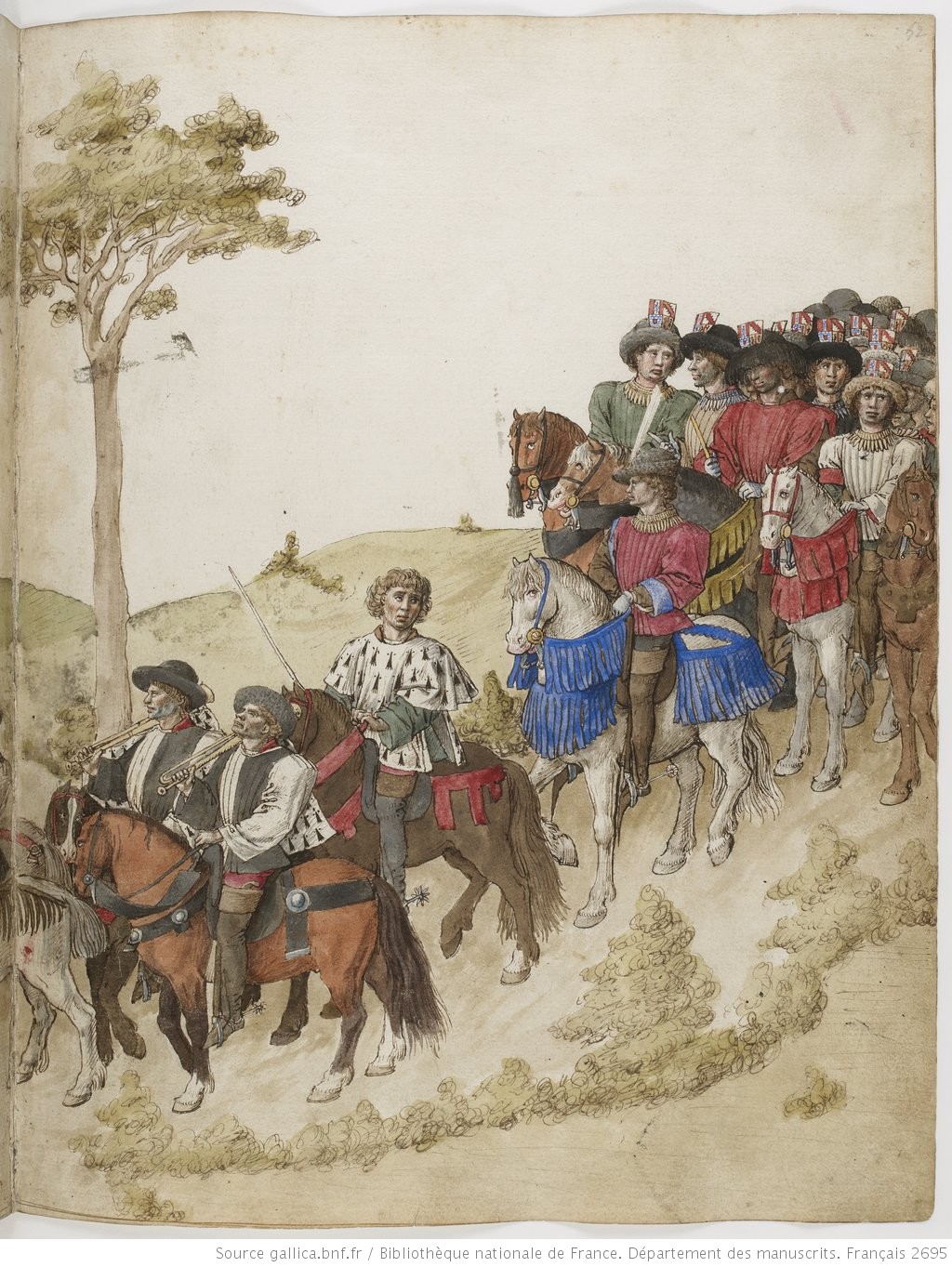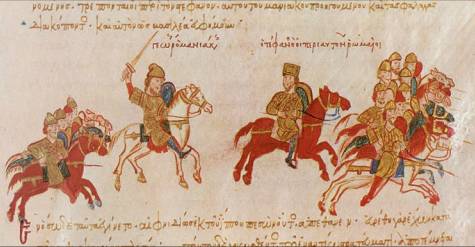Greetings, Children of Misrule.
Today we talk about horses.
Specifically, medieval war horses and their relationship with their riders. I have some things to say about them, and I will finish this post with a centuries-old traditional Greek song about a fighter and his horse.
When we talk about mounted combat in the late middle ages, we are generally talking about knights. The French word for a knight, chevalier, as well as the English word for chivalry, both indicate the prominent role of the animal: the Old French chevalerie comes from the late Latin caballerius or caballarius, meaning ‘horseman’.
The horse was the chivalric animal par excellence, ostensibly a knight’s most valuable possession. In France they were called destriers, they were expensive and ‘of noble size’, which means larger than the common horse – normal horses would be called rounceys or amblers, and a knight’s retinue would use them for travelling and carrying things around.
Larger in size than the usual mounts, knight’s warhorses and destriers were reserved for battle and tournaments, and they were not used otherwise. To that end, they received a long, expensive and specialised combat training. Illuminations from the fifteenth century, as the ones in the Livre des Tournois illuminated by Barthélemy d’Eyck, demonstrate the difference between a warhorse and a simple mount. In ordinary horses, the rider’s feet reach under the animal’s belly, almost to the ground. Warhorses were larger and were mounted differently, to facilitate combat from horseback. The reach of the riders’ feet in the illumination indicates the difference in the type of the horse and riding style.


Alongside the horse, the rider also needed to be trained extensively in mounted combat. A man had to invest time and resources to his preparation as a knight, which accounts for the fact that chivalry was limited to the higher social classes who could afford the costs. A warhorse and its equipment were at once a knight’s attribute and a signifier of his social status. In fact, according to the De medicina equorum, the thirteenth-century treatise on hippiatry and horsemanship, a horse is the only factor that determines one’s nobility.
In romance literature, a knight leaving on horseback is an indication that he is going on an adventure. The knight’s horse was more than a mount, however.The horses and riders share a special bond and some horses are presenting anthropomorphic traits. These traits are quintessentially human: they appear intelligent, they can show affection and they can communicate feelings, being particularly eloquent in non-verbal, physical communication. In Aliscans, a twelfth-century chanson de geste written in Old Picard language, the relationship between horse and rider is almost metaphysical. In the story of Giraud de Cabrières, the catalan knight, the hero communicated with his horse through their own secret language. Moreover, according to a longer tradition that can be traced back to at least Isidore of Seville’s Etymologiae, horses can foresee the outcome of battles: Isidore mentions that soldiers could make such predictions based on the eagerness or not of their horses to engage.

All this is very interesting and researching it made me feel like a respectable medievalist and a scholar of some ability. After having written an entire chapter on horses, I found myself in an Easter fair in Greece, listening to a traditional song about a fighter and his horse. It must have been the millionth time in my life that I was listening to this song, but after months of looking up warhorses, this time I was hearing things that were not there before.
For the Greek speakers, here is the original version. It is traditional to Thessaly, and judging by the topic, themes and structure, I would date it (or parts of it) anywhere from the fifteenth to the eighteenth century. Folk poetry is beautifully and annoyingly elusive of proper dating, though. At least to me.
Since it is not translated in English, here is my feeble attempt to present you with the story. Not in rhyme, alas, but I hope you will still enjoy it.

It is the day of St Constantine, therefore late spring, and the village is holding a fair and a feast. The feast is grand and the water is running low, the people are thirsty and there is no water to drink. I like to think that this is the poem’s subtle way to imply that they are probably drinking more wine than they would normally have.
In attendance are three brothers and warriors, and their troops. Captain Alexios is probably the oldest and certainly the highest ranking. His brothers are John the brave, and the youngest one, the castle warrior. The youngest brother remains unnamed, although he has a warrior’s title, probably because he is too young of age. Their black horses are nearby and they are also grazing. John’s horse is grazing on iron, Alexios’ steed is munching some stones, and the youngest’s horse is eating its own harness bridle.
These horses are tough. As tough as their riders.
As they are feasting and drinking and singing, a little bird lands on their table. It is not singing as a bird, but instead it speaks in human tongue:
‘As you three are sitting here eating and feasting, the enemy is taking away what’s yours’. They have taken John’s son, the bird informs them, and also Alexios’ wife and the youngest’s fiancee. The older brothers order the young one to go scouting and see how large the pillaging army is.
‘If they are counting thousands of soldiers’ they say ‘just go in and kill them all; if it’s more than that, come and get us and we’ll join you’.
This is where it gets interesting.
The young warrior goes to his horse and talks to it. He asks, is the horse willing to carry him to this scouting mission? The horse replies, in human words ‘Master, I ‘ll take you there, if you give me five extra handfuls of food and two extra buckets of water’. It might sound like a negotiation, but you will find out that it is actually foresight. The horse wants to be at peak strength. Many things can go wrong in this mission.
The young warrior grants the wish and rides away for scouting. He sees the enemy’s’ troops and there are thousands of them, covering the entire field. He is too proud to go back to his brothers for assistance, but he is also afraid to go forward. He is a hero, but he is also a young man.
He leans, kisses his horse and asks:
‘Are you willing, my steed, to go and swim in blood?’
‘I am willing, my master, and I shall swim in blood. Just tie your head tightly with a gilded scarf, because it will be a fierce and brutal ride, and I will jump and trample; and this could make you dizzy, and you could fall and get hurt’.
Let me take a moment here to comment on the badassery. The horse will storm in thousands of enemies, and it is only worried that it will be riding too fiercely and its rider might get dizzy and fall and hurt himself. The thousands of enemies are obviously nothing to worry about. He’s got this. The horse is eager and it trusts its rider. It predicts the battle’s outcome.
The horse is right. The young warrior enters in battle like an eagle and comes back out like a hawk, and killing a thousand men on his way in and two thousand men on his way out. Then he goes back in and kills the rest of them, he finds John’s son and Alexios’ wife, and he leaves carrying his fiancee on the back of his horse. On his way back, he calls to his brothers:
‘Brothers, if you are on my way, move aside and follow me; because my eyes are blurry and I can’t see any of you’.
Well, this is a very heroic story and it is obviously influenced by medieval chivalric romances and their byzantine counterparts, the Acritic songs. There are many studies about them and I will not go into this now, nor will I dwell in the connection between them and Greek folk poetry; all this is information you can easily find elsewhere.
I just wanted to comment on the relationship between horse and rider, which is what fascinated me again with a song that I have sung countless times. I love it when I find medieval patterns repeating and persisting through folklore. The horse knows there will be trouble and it makes sure it will be up for it. It does not hesitate, and it does not doubt. It trusts the young warrior, but it also cares for him: the words of the original text combine excellently the description of fierce bloodshed with a feeling of affection, when the horse is giving advice to the rider about how best to protect himself. ‘Tie your head with a gilded scarf’. Stay safe. Also with a bit of luxury.
On a final note, I am always amazed by the awareness of the human psyche that folk poetry displays. In the end, the boy has killed so much that he asks his brothers to get out of his way, because he is so much in the war haze that he cannot tell apart friend or foe. In later years, they would call this PTSD.
He is so lucky to have had such a horse!
Featured Image:
Detail of a miniature of a horse at the beginning of the text about that animal, from a bestiary with theological texts, England, c. 1200 – c. 1210, Royal MS 12 C XIX, f. 34r
Further reading:
Oxford English Dictionary, “chivalry’
Isidore of Seville, Etymologies, XII.i.44.
John Clark, The Medieval Horse and Its Equipment, C.1150-c.1450, Medieval Finds from Excavations in London (Boydell Press, 2004).
Marina Viallon, “Fiers destriers : images du cheval de guerre au Moyen Âge,” In Situ, no. 27 (September 24, 2015)
Alison Langdon, Animal Languages in the Middle Ages: Representations of Interspecies Communication, The New Middle Ages (Springer, 2018).
Le cheval dans le monde médiéval, CUER MA (Center : Aix-en-Provence), 1992.

Leave a comment